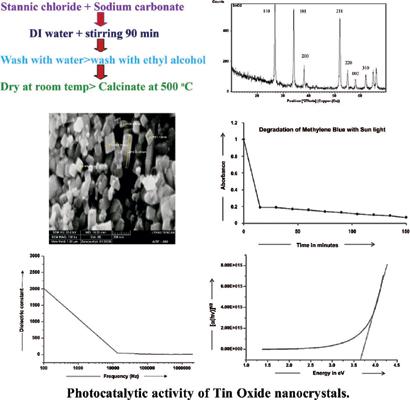Current Nanoscience ( IF 1.4 ) Pub Date : 2021-06-30 , DOI: 10.2174/1573413716666201215170717 Shatendra, Sharma

|
Background: Tin oxide nanoparticles also show good photocatalytic efficiency due to wide bandgap and high recombination rates of photo-generated electron-hole pairs. Being non-toxic and chemically stable, the tin oxide nanoparticles are used as dynamic photo-catalyst for the degradation. Tin oxide nanocrystals suitable for charge storage devices are synthesized using the coprecipitation technique.
Objectives: Synthesis of Tin oxide nanocrystals by using the co-precipitation method for photocatalytic activity under sunlight that can be used for photo-degradation. The method of synthesis and characterization are also discussed.
Materials and Methods: The nanocrystals are prepared by co-precipitation method using stannic chloride and sodium carbonate. Sodium carbonate is added under constant stirring drop by drop for 90 minutes. The solution is settled for 4 hours. The precipitates are first washed using de-ionized water and then with ethyl alcohol. The dried powder of nanocrystals is then calcinated at 500°C for one hour in a muffle furnace. The structural, morphological, optical, and electrical characterization of these synthesized crystals is done using (XRD), (FESEM), (TEM), (UV-Visible), (FT-Raman), Zeta potential, and dielectric constant measurements.
Results and Discussion: The sizes of synthesized nanocrystals vary from 25 nm to 100 nm and are found to be optically transparent. The dielectric constant of nanocrystals is measured in the frequency range of 100Hz-1MHz and it can be seen that it declines from ~2000 at a frequency of 100Hz to ~30 at 1MHz. However, this decline in dielectric constant with frequency can be explained well on the basis of strong space charge polarization and rotational direction polarization processes in nanostructures. In the high-frequency regions, these processes cannot follow the electrical field frequency variations that result in the rapid decrease of dielectric constant.
Photocatalytic Activity: The photocatalytic activity of the particles under sunlight is also investigated, which shows that the crystals show degradation of the methylene blue dye under sunlight irradiation.
Theoretical Investigations with DFT: The bandgap of the particles was also calculated from the UV-VIS spectra, which was found to be ~3.6 eV and this experimentally observed value of bandgap matches with that calculated theoretically from Density Functional Theory (DFT) using Local Density Approximation (LDA).
Conclusion: The method of synthesis reported in the present paper is scalable and can be used for the commercial synthesis of SnO2 nano-crystals for electrodes and energy storage devices.
中文翻译:

氧化锡纳米晶的合成、表征和光催化活性
背景:由于光生电子-空穴对的宽带隙和高复合率,氧化锡纳米颗粒也表现出良好的光催化效率。由于无毒且化学稳定,氧化锡纳米颗粒被用作降解的动态光催化剂。适用于电荷存储装置的氧化锡纳米晶体使用共沉淀技术合成。
目的:利用共沉淀法合成氧化锡纳米晶,在阳光下具有光催化活性,可用于光降解。还讨论了合成和表征的方法。
材料和方法:纳米晶体是通过使用氯化锡和碳酸钠的共沉淀法制备的。在恒定搅拌下逐滴加入碳酸钠90分钟。溶液静置4小时。沉淀物首先用去离子水洗涤,然后用乙醇洗涤。然后将干燥的纳米晶体粉末在马弗炉中在 500°C 下煅烧一小时。这些合成晶体的结构、形态、光学和电学表征是使用 (XRD)、(FESEM)、(TEM)、(UV-Visible)、(FT-Raman)、Zeta 电位和介电常数测量完成的。
结果和讨论:合成的纳米晶体的尺寸从 25 nm 到 100 nm 不等,并且发现是光学透明的。在 100Hz-1MHz 频率范围内测量纳米晶体的介电常数,可以看出它从 100Hz 频率时的~2000 下降到 1MHz 时的~30。然而,这种介电常数随频率的下降可以根据纳米结构中的强空间电荷极化和旋转方向极化过程很好地解释。在高频区域,这些过程无法跟随导致介电常数快速下降的电场频率变化。
光催化活性:还研究了颗粒在阳光下的光催化活性,这表明晶体在阳光照射下显示出亚甲基蓝染料的降解。
使用 DFT 进行理论研究:粒子的带隙也是从 UV-VIS 光谱中计算出来的,发现它是 ~3.6 eV,这个实验观察到的带隙值与使用局部密度从密度泛函理论 (DFT) 理论计算的值相匹配近似(LDA)。
结论:本文报道的合成方法具有可扩展性,可用于电极和储能器件的 SnO2 纳米晶体的商业合成。










































 京公网安备 11010802027423号
京公网安备 11010802027423号